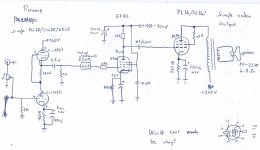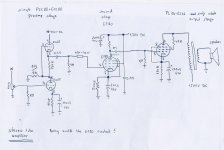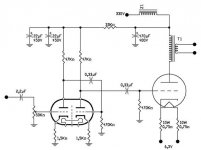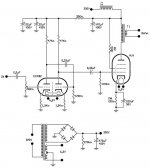The PL36 needs a grid leak resistor. The 68k grid stopper on the EF80 may be rather high, unless this is intended to be guitar amp. You may need to check what range of g2 voltages is appropriate for the EF80.
My hunch is that this amp will have a lot of gain, and could suffer from overloading in the EF80 stage.
My hunch is that this amp will have a lot of gain, and could suffer from overloading in the EF80 stage.
Dug, looking at the schematic it appears that the ECC88 has 150 ohm cathode resistors on both sections.
There does seem to be a lot of gain here, probably 26 - 28dB in the SRPP alone.
I believe you want a resistor in the screen supply of the EF80, probably in the vicinity of 4X the plate load resistor. The 68K resistor on the grid of the EC80 will contribute significant noise, I'd reduce this to 10K or less if there are no stability issues with this pentode. What is the load? (Don't recognize your symbol)
I assume the ECC88 cannot swing sufficient voltage to comfortably drive the PL36, it's not a familiar type and I have not checked. I would add the missing grid resistor and probably a grid stopper (1K or so) right at the socket to reduce the likelihood of oscillations.
There does seem to be a lot of gain here, probably 26 - 28dB in the SRPP alone.
I believe you want a resistor in the screen supply of the EF80, probably in the vicinity of 4X the plate load resistor. The 68K resistor on the grid of the EC80 will contribute significant noise, I'd reduce this to 10K or less if there are no stability issues with this pentode. What is the load? (Don't recognize your symbol)
I assume the ECC88 cannot swing sufficient voltage to comfortably drive the PL36, it's not a familiar type and I have not checked. I would add the missing grid resistor and probably a grid stopper (1K or so) right at the socket to reduce the likelihood of oscillations.
I assume the ECC88 cannot swing sufficient voltage to comfortably drive the PL36, it's not a familiar type and I have not checked. I would add the missing grid resistor and probably a grid stopper (1K or so) right at the socket to reduce the likelihood of oscillations.
The EL/PL36 is a nice device when triode strapped. It is rather linear and has low plate resistance (around 650R) but good gain because of the healthy gm. At 200-220V/60-70mA and 2.5-3K primary load you only need about 30V peak to get about 2.5-3W at 5% THD.
In PP Class AB1 triode strapped things become very interesting...
Last edited:
Dug, looking at the schematic it appears that the ECC88 has 150 ohm cathode resistors on both sections.
...
I see it now...looked like 450 on the top one.
The EF80 has quite a high gm, and therefore only a limited grid swing between cutoff and grid current. You have put quite a lot of gain in front of it. I am puzzled what your source is, that needs so much gain.
The resistor (1k/1M?) from the first triode anode to ground should be omitted. If 1M it does almost nothing. If 1k it shorts the anode.
My guess is that the PL36 output needs a rather smaller value for grid leak than 1M. Check the data sheet.
As to 'OK for a stereo tube amp' my answer would be no, but those who like SET sound would differ.
The resistor (1k/1M?) from the first triode anode to ground should be omitted. If 1M it does almost nothing. If 1k it shorts the anode.
My guess is that the PL36 output needs a rather smaller value for grid leak than 1M. Check the data sheet.
As to 'OK for a stereo tube amp' my answer would be no, but those who like SET sound would differ.
Okay so I found a simpler schematics that uses a PL36,but my problem is that for a stereo i need two ECC82,but I have only one.Then I checked the datasheet and it was very similar to the PCC88,has the same pinout and looks very similar ...
Can I use the PCC88 in the place of the ECC82 in this schematics,or do I need to change anything
Can I use the PCC88 in the place of the ECC82 in this schematics,or do I need to change anything

Attachments
But it would work OK ? which resistors must I change,and how much power could this amp produce ?
Would the PCC88 and PL36 work ok for a stereo amp ?
The PCC88 is basically identical to the ECC88 except the filament runs at 7.6V/300mA instead of 6.3/365mA.
As you need about 260V supply for the PL36 (5-10V drop across the primary of the transformer, 220V plate voltage and 30V bias) you have enough supply to run the PCC88 properly. From the 260V supply make 1-2 RC filters in order to get about 220V. The PCC88 will have 22K anode resistor and 600R cathode resistor. This way it will run at about 110V/5mA with -3V bias. The gain will be nominally 26.5 which means that you will get full power with about 0.8V rms input.
So you only need one PCC88 for both channels. It is not very sensitive for my taste but should be enough if you use a CD player or computer.
Last edited:
- Status
- This old topic is closed. If you want to reopen this topic, contact a moderator using the "Report Post" button.
- Home
- Amplifiers
- Tubes / Valves
- Vacuum tube amp design



